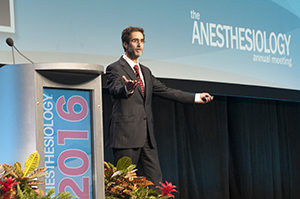
Daniel Sessler, M.D.: ‘We all need to contribute to stopping postoperative mortality.’
Preventable mortality associated with anesthesia is almost nonexistent after efforts by anesthesiologists and others to reduce intraoperative mortality over the past 30 years, according to Daniel Sessler, M.D., who presented Tuesday’s John W. Severinghaus Lecture on Translational Science, which was titled “Lost in Translation.”
“Preventable anesthesia mortality is now thought to be one in 100,000 cases, so low that it’s hard to measure. This didn’t happen by magic. It happened because of a decades-long, conservative effort by basic scientists, translational investigators and clinicians. This is a remarkable accomplishment,” said Dr. Sessler, the Michael Cudahy Professor and Chair of the Department of Outcomes Research at Cleveland Clinic.
However, mortality related to surgery is the third-leading cause of death in the United States, mainly due to myocardial infarction (MI). Anesthesiologists should take the lead in trying to reduce post-surgical mortality through troponin screening, he said.
“MI is the leading cause of death after surgery, and 80 percent are silent. They are only detected by troponin screening. We should be screening for troponin. This is to detect for a condition that could kill patients,” Dr. Sessler noted.
A positive troponin test should prompt anesthesiologists to consult with a cardiologist so the cardiologist can examine the patient and prescribe medication to control any hypertension or dyslipidemia and counsel the patient on lifestyle changes, such as smoking cessation, exercise and a healthy diet.
“Ninety percent of heart attacks occur within three days after surgery. Hypotension and tachycardia likely contribute to those deaths. Hypotension is common and prolonged in postsurgical hospital wards, but ward patients are barely monitored for it,” Dr. Sessler said. “Clinicians should advocate for continuous ward monitoring of postoperative patients for hypotension and other signs of heart disease.
“We all need to contribute to stopping postoperative mortality.”
Return to Archive Index